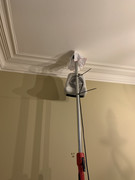I didn't suggest there was a "requirement" to fit a rotary isolator close to the outside unit of an AC/HP. However you'll be hard-pressed to find a commercial installation without one for the reasons I detailed above.Oldgreybeard wrote: ↑Thu Nov 24, 2022 10:45 amI've locked off supplies many times over the years. Almost all of those lock offs will have been with a bog standard lockable clamp, with a small padlock fitted to it and a warning tag with my name on it. I can count on one hand the number of times I've locked off a rotary isolator, TBH. I've also locked off standard 13A switch fuses a few times, just pull the fuse and stick a cable tie and warning flag through the empty fuse holder. My bag of goodies includes half a dozen standard lock-off clamps that will fit any circuit breaker or RCD etc with a manual operation lever. I would be very surprised if any electrician didn't also have lock-off clamps and understand how to use them for safe isolation, TBH. There has never, ever, been any requirement in the regs for an isolator to be within eyesight at the point of work.Stinsy wrote: ↑Thu Nov 24, 2022 10:33 amAnd that is perfectly acceptable in a domestic setting. Imagine a shop/office/factory, the guy working on the outside unit needs to be able to isolate it within eyesight so that he can be confident no one will re-energise it without his knowledge.Oldgreybeard wrote: ↑Thu Nov 24, 2022 8:49 am I just fitted a 13A fused DP switch next to the indoor unit, spurred off the ring (happened to be a double gang socket right below where I fitted the indoor unit). Makes it easy to isolate the power to work on it, could even pull the fuse out as an extra safety measure. These things need a fused supply anyway, so this seemed the easiest way to do it.
If someone wants to fit a rotary isolator next to the external unit at their house, they can. But it isn't "required".
However for a domestic install I wouldn't (And didn't) bother.
